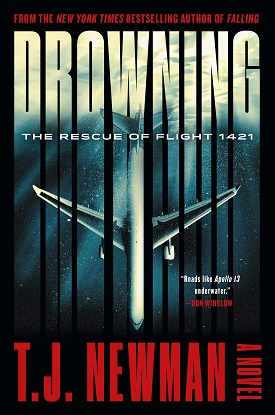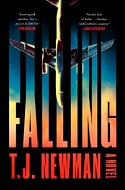 Synopsis:
Synopsis:
Six minutes after takeoff from Honolulu, Flight 1421, bound for San Francisco, crashes into the Pacific Ocean between the Hawaiian islands of Moloka’i and Lana’i. During the evacuation, an engine explodes and the plane is flooded. Those still alive are forced to close the doors. But it’s too late. The plane sinks to the bottom of the sea with twelve passengers trapped inside.
More than two hundred feet below the surface, engineer Will Kent and his eleven-year-old daughter Shannon are waist-deep in water and fighting for their lives.
Their only chance at survival is an elite rescue team on the surface led by professional diver Chris Kent — Shannon’s mother and Will’s soon-to-be ex-wife. They must work with Will to find a way to rescue the passengers, including their daughter, from the sealed airplane, which is now teetering on the edge of an undersea cliff.
There’s not much time.
There’s even less air.
Drowning: The Rescue of Flight 1421 is the story of a family’s desperate fight to save themselves and the people trapped with them . . . against impossible odds.
Review:

Drowning: The Rescue of Flight 1421 proves conclusively that the success of author T.J. Newman’s riveting debut, Falling, was not a fluke. Her sophomore effort, Drowning: The Rescue of Flight 1421, is equally terrifying, absorbing, and emotionally satisfying. In fact, her characters and their plights are even more sympathetic, and the story more heartbreaking but, ultimately, life-affirming.
Newman considers her post-college stint at Changing Hands bookstore in Tempe, Arizona, her first step toward becoming a bestselling novelist. No one knew that she was laboring as a bookseller by day and writing in her bedroom at night, contemplating how to accomplish her goal of becoming a published writer. At her mother’s suggestion, she segued into and loved flying, and her ten-year career as a flight attendant supplied the inspiration for Falling.
Newman says she knew that the follow-up to her staggeringly successful first novel had to be “bigger. In every aspect, it had to be bigger. Bigger heart, bigger action, bigger stakes.” It is. Searching through her trove of story ideas amassed during her flying days, she recalled yet another red-eye flight from Hawaii to Los Angeles. The flight path from Hawaii to the mainland is the longest in the world with no suitable alternate route. During that flight, she looked out the porthole window in the door of the forward galley “at nothing. There’s nothing out there for hours and miles in every direction. It is nothing but a pitch black void. Nothing but water.” She pondered, “What if something happened? What if we went down? How would they find us out here? How would they come get us? How would they save us? How would we save ourselves?” And she is captivated by how ordinary people react when they find themselves in a heightened situation. “I think we all discover parts of ourselves that we didn’t now were there when we’re in hot water and I’m fascinated by that.”
“In aviation, the emergency landing of an aircraft on water is called a ditching,” according to Drowning: The Rescue of Flight 1421’s brief prologue. Thinking back to that vast nothingness except water, Newman contemplated the worst case scenario: the pilot announces “prepare to ditch” and the plane crashes into the ocean before sinking with passengers and crew members trapped inside. And it comes to rest teetering on the edge of an underwater cliff. From there, Newman “reverse engineered” the story by understanding how that circumstance might actually occur. But found it “really tricky” to figure out how to make the fictional plane crash because, theoretically, the events in the book should not play out due to safety mechanisms and protocols. But her research revealed that they could.
So, for instance, a pilot should never have a “dead stick,” meaning no hydraulic fluid and no hydraulic power. Planes have “three hydraulic lines. Two layers of redundancy in case of a system failure.” Those backup systems should ensure that the loss of an engine does not eliminate the pilot’s ability to navigate the aircraft and, if necessary, either return to the airport where the flight originated (in this case, Honolulu) or land at an alternate location (which, in Drowning: The Rescue of Flight 1421 would be either Kahului Airport on Maui or Kona Airport on Hawaii). But because the plane will not continue gaining altitude and the pilot literally cannot turn the plane around, there is only one place for it to land: southwest of Moloka’i in the narrow channel between that small, largely uninhabited island and the nearby island of Lana’i where trade winds blow every day. The shelf is known as Penguin Bank.
Newman establishes Flight 1421’s predicament in a straight-forward, unembellished style that makes the sheer terror the passengers and crew are experiencing palpable and believable. She demonstrates various characters’ response to crisis. For some, their worst traits come to light while others unexpectedly become heroes. Newman wisely recognized that the spectacle of the disaster could not sustain the story unless her readers became invested in the well-being of the twelve people trapped in the plane. So, with the plane sinking to the bottom of the sea and readers fully engrossed in the action, she winds the story back three hours and examines the history of her main characters, engineer Will Kent, his estranged wife Chris, and their eleven-year-old daughter, Shannon. Their oldest daughter, Annie, died tragically six years ago in a maddeningly preventable accident. Losing her has caused her parents, especially Will, to become overprotective of Shannon. For that reason, Will is going to fly with Shannon to San Francisco where she will attend summer camp, and immediately return to Hawaii. Shannon is appropriately mortified. Annie’s bedroom has remained as she left it, symbolic of the stasis in her parents’ relationship that has led to their pending divorce. They have spent the years since Annie’s death wracked with guilt and pain, believing that if “they dealt with their marriage or changed the house or cleaned out Annie’s room, they’d be moving forward. Which would mean they’d be leaving Annie behind.”
Will and Shannon survive the crash, as does another young girl traveling alone, eight-year-old Maia Taylor. ALong with Will, female pilot Kit shoulders responsibility for ensuring that everyone trapped in the fuselage gets out alive. Through flight attendants Molly and Kaholo Newman again emphasizes that “flight attendants are first and foremost safety and security professionals. Full stop.” An elderly couple traveling together, Ruth and Ira Belkin, and Ryan Wang, whose new bride is killed on impact, are particularly memorable. As the oxygen supply dwindles, Will and Kit take the lead in communicating with military personnel charged with organizing a mass rescue operation (MRO) from the USS Theodore Roosevelt, a 101,000-ton Nimitz-class aircraft carrier. Under normal circumstances, Chris’s blatant conflict of interest and lack of objectivity would preclude her from becoming part of the rescue operation. However, Chris and her colleagues are civilian contractors hired to perform routine hull maintenance on the ship. When she learns that Will and Shannon’s flight has crashed, she refuses to be sidelined while possible rescue strategies are debated. None of the military personnel have ever undertaken such a rescue operation and Chris possesses invaluable special expertise. No one is more motivated than she to see the MRO succeed. After all, it is her family that is trapped some two hundred feet below the water’s surface.
Newman notes that one thing the rigorous training provided to flight attendants does not address is how to respond if a plane sinks to the bottom of the ocean with survivors of the crash inside, so she was required to conduct extensive research to make that aspect of the story credible, as well. For one thing, she had to change her mindset because normal aviation protocols are no longer applicable. She says the plane is no longer an aircraft — it has, as a practical matter, been transformed into a “submarine.” Her depiction of the trial-and-error attempts to rescue the trapped survivors is heart-stoppingly tense, fraught with uncertainty, and completely engrossing. Those scenes are indeed emotionally wrenching because Newman has, by that point in the story, deftly convinced readers to care deeply about the survivors’ fate.
Drowning: The Rescue of Flight 1421 is a propulsive, unpredictable thriller. Newman’s narrative is tautly crafted with no surplusage and moves at a steady pace, with shocking developments delivered at expertly timed junctures that compel the story forward. Newman never loses control of the speed at which the tale unfolds, restraining it from becoming frantic. Rather, critical story developments occur at realistic intervals, giving readers a chance to brace themselves for the next complication, reason to hope, or heartbreaking loss. And, of course, losses are an expected and credible part of the story.
Newman made a conscious effort to incorporate more details about the passengers in her second novel than she did in Falling, largely because she realized that most of her readers are actual or potential passengers themselves and, accordingly, put themselves in the characters’ places and are most interested in the trajectories of their stories. The approach is highly effective. At its core, though, Drowning: The Rescue of Flight 1421 is the story of a family. With Will and Shannon in peril, Chris will stop at nothing to save them, including risking her own life. Like Will, she is convinced that she will not survive if Shannon does not. Her feelings for Will are complicated, as are his for her. Like the aircraft’s cabin, when the story opens, their marriage is teetering on a cliff and rapidly running out of oxygen. Both characters are fully formed, flawed, and empathetic, and Shannon, who continues to mourn her big sister, is particularly endearing. Newman never allows her story to lapse into melodrama or her characters to become cloying, demonstrating that she is equally adept at creating compelling characters and inventing terrifying situations in which to place those characters.
Drowning: The Rescue of Flight 1421 cements Newman’s stance as a first-rate writer. She says she is working on her third novel and her goal is to amp the dramatic tension up even further, which is hard to imagine. Drowning: The Rescue of Flight 1421 is the best of two genres – a horrifyingly realistic thriller to which anyone who has ever been a passenger in an airplane can readily relate and an emotionally rich exploration of the impact of grief, isolation, guilt, and an inability to effectively communicate on a marriage, a family, and, most importantly, a surviving sibling. It is sure to be on not only every bestseller list, but every list of the best books of 2023.





Comments are closed.